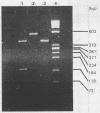Abstract
A polymerase chain reaction (PCR) was developed for Chlamydia trachomatis in which a 380 base pair DNA fragment was amplified. Amplification occurred with the DNA from the 15 serovars but not with that from other Chlamydia spp or with DNA from a variety of other organisms. Chlamydial DNA (10(-16) g) could be detected and the PCR seemed to be able to detect single organisms. Urethral swabs were obtained from 37 men with acute non-gonococcal urethritis (NGU), 18 (49%) of whom were positive for C trachomatis by MicroTrak. As a result of clinical re-examinations 65 urethral swabs were available for analysis by the PCR. In comparison with MicroTrak, PCR had a sensitivity of 95%, a specificity of 94%, a positive predictive value of 86% and a negative predictive value of 98%. The PCR was apparently less sensitive (82%) in tests on urine samples. Overall, however, values of sensitivity and specificity of the PCR compared favourably with those of MicroTrak. The PCR for C trachomatis is likely to be a valuable technique for research, but problems of DNA contamination suggest that it should not be recommended for routine diagnosis.
Full text
PDF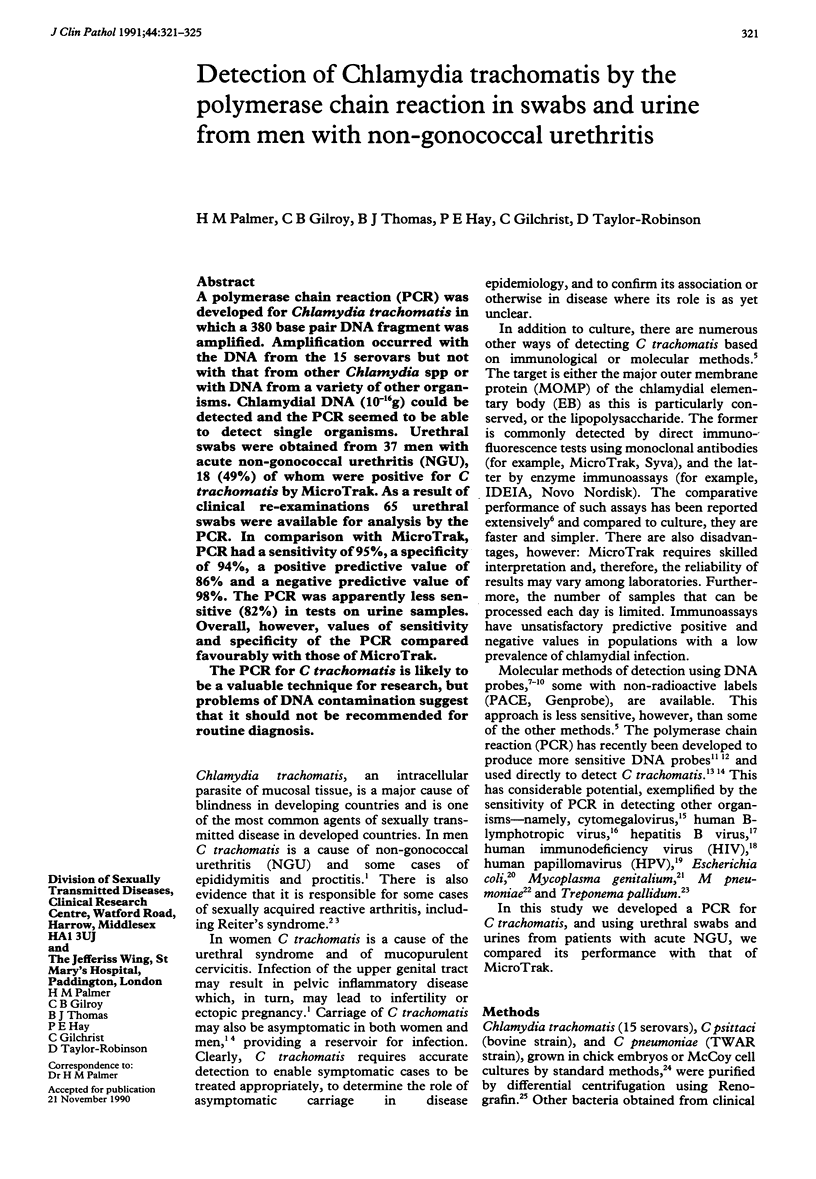
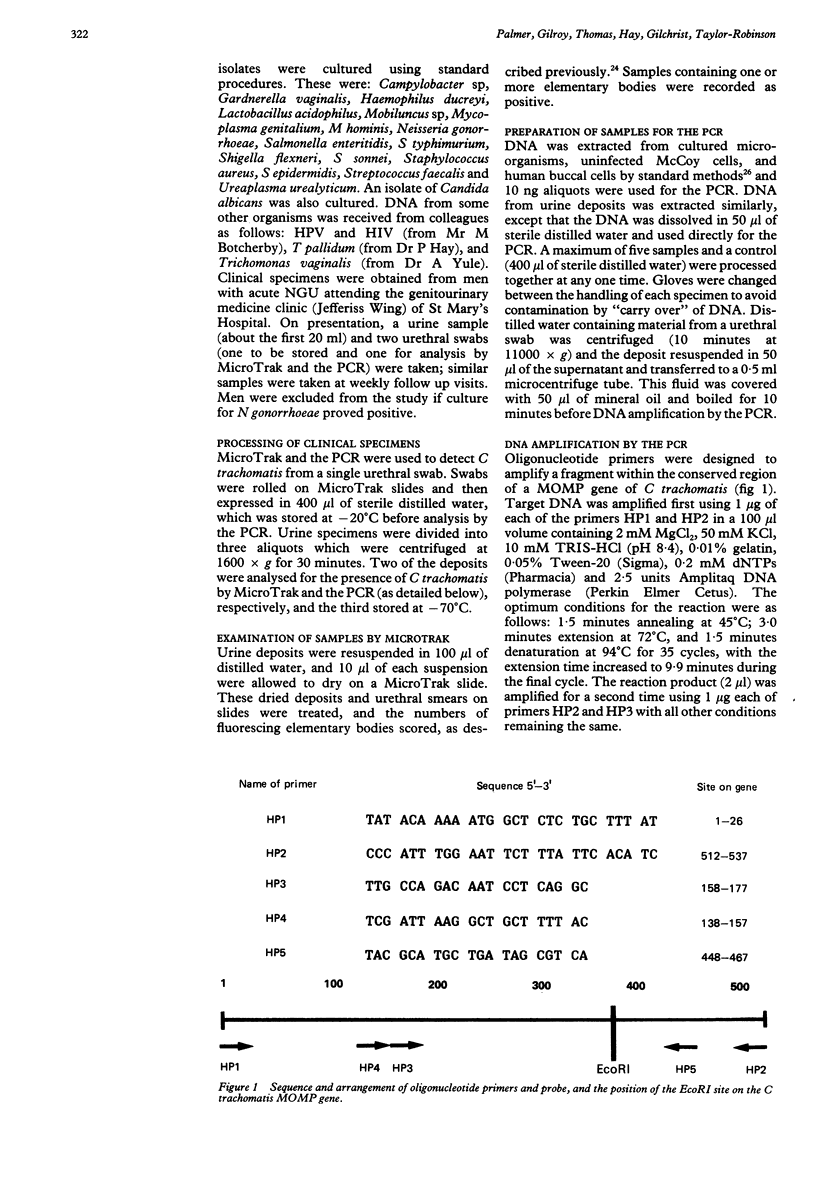
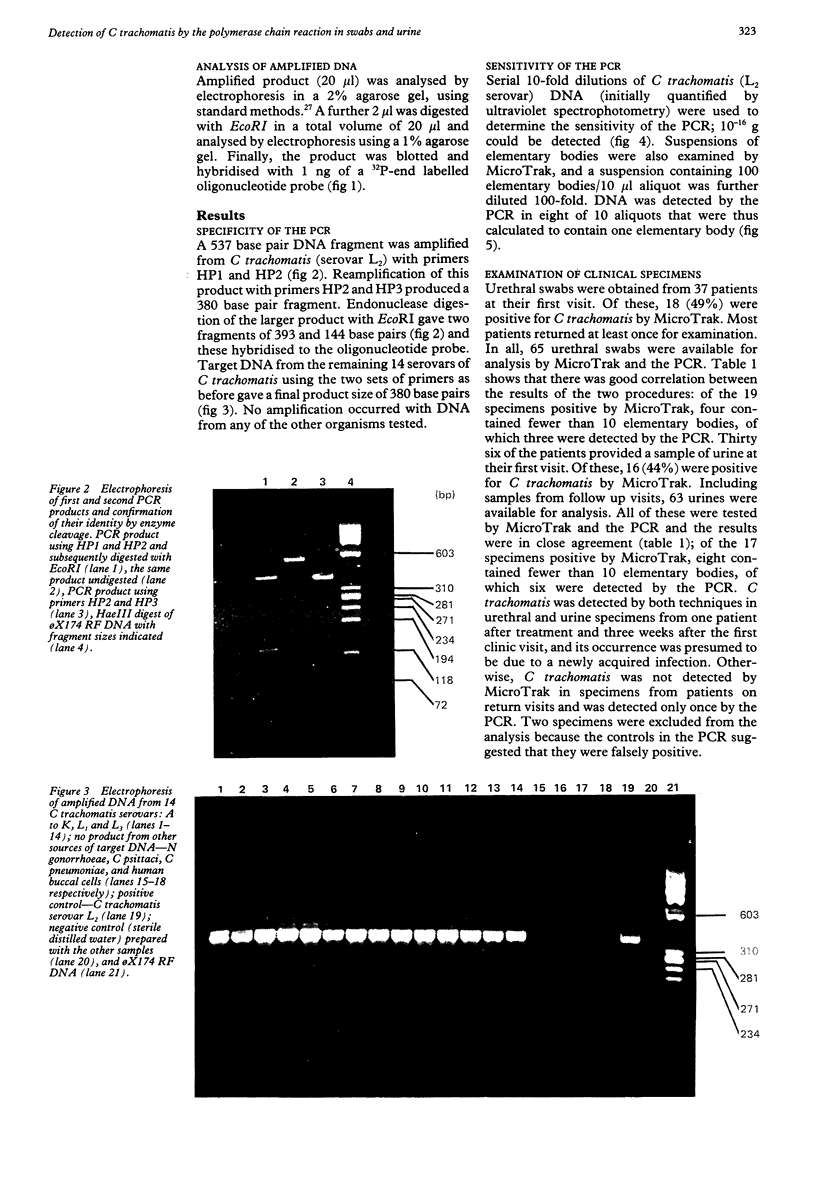

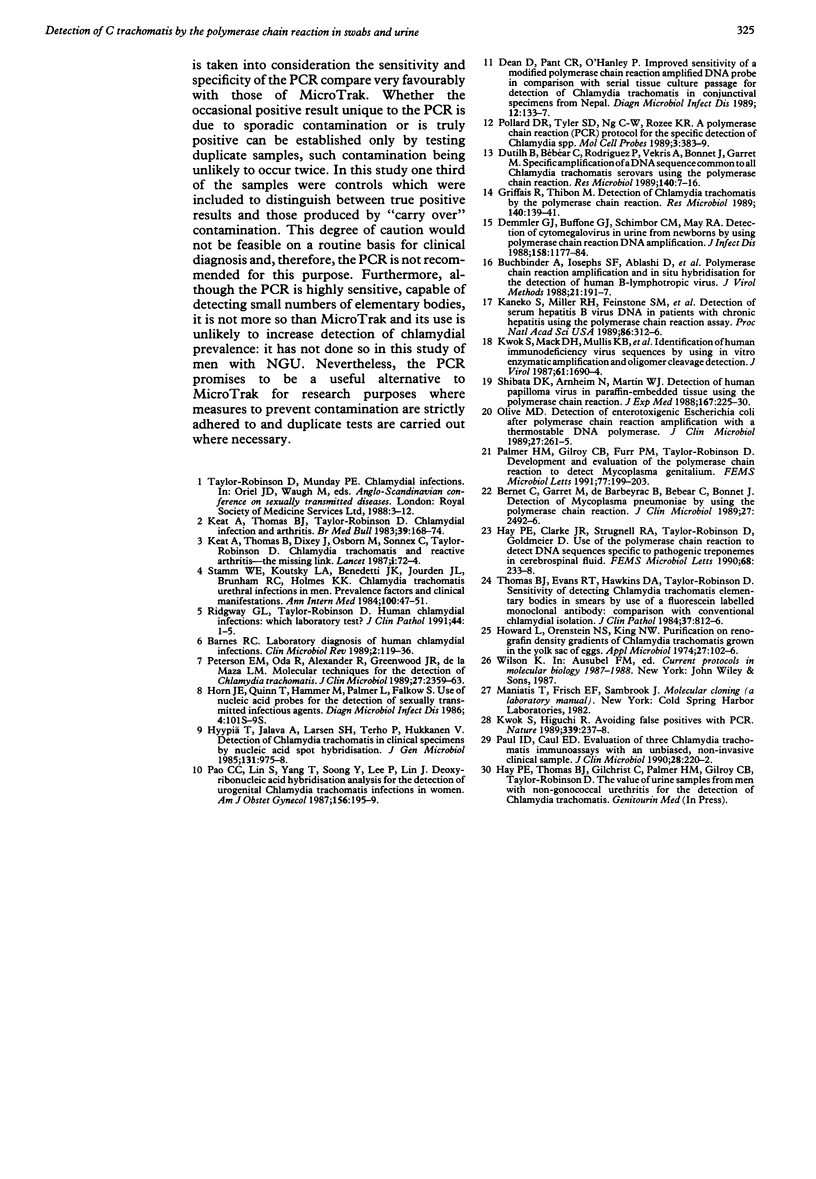
Images in this article
Selected References
These references are in PubMed. This may not be the complete list of references from this article.
- Barnes R. C. Laboratory diagnosis of human chlamydial infections. Clin Microbiol Rev. 1989 Apr;2(2):119–136. doi: 10.1128/cmr.2.2.119. [DOI] [PMC free article] [PubMed] [Google Scholar]
- Bernet C., Garret M., de Barbeyrac B., Bebear C., Bonnet J. Detection of Mycoplasma pneumoniae by using the polymerase chain reaction. J Clin Microbiol. 1989 Nov;27(11):2492–2496. doi: 10.1128/jcm.27.11.2492-2496.1989. [DOI] [PMC free article] [PubMed] [Google Scholar]
- Buchbinder A., Josephs S. F., Ablashi D., Salahuddin S. Z., Klotman M. E., Manak M., Krueger G. R., Wong-Staal F., Gallo R. C. Polymerase chain reaction amplification and in situ hybridization for the detection of human B-lymphotropic virus. J Virol Methods. 1988 Sep;21(1-4):191–197. doi: 10.1016/0166-0934(88)90065-1. [DOI] [PubMed] [Google Scholar]
- Dean D., Pant C. R., O'Hanley P. Improved sensitivity of a modified polymerase chain reaction amplified DNA probe in comparison with serial tissue culture passage for detection of Chlamydia trachomatis in conjunctival specimens from nepal. Diagn Microbiol Infect Dis. 1989 Mar-Apr;12(2):133–137. doi: 10.1016/0732-8893(89)90003-5. [DOI] [PubMed] [Google Scholar]
- Dutilh B., Bébéar C., Rodriguez P., Vekris A., Bonnet J., Garret M. Specific amplification of a DNA sequence common to all Chlamydia trachomatis serovars using the polymerase chain reaction. Res Microbiol. 1989 Jan;140(1):7–16. doi: 10.1016/0923-2508(89)90053-3. [DOI] [PubMed] [Google Scholar]
- Griffais R., Thibon M. Detection of Chlamydia trachomatis by the polymerase chain reaction. Res Microbiol. 1989 Feb;140(2):139–141. doi: 10.1016/0923-2508(89)90047-8. [DOI] [PubMed] [Google Scholar]
- Hay P. E., Clarke J. R., Strugnell R. A., Taylor-Robinson D., Goldmeier D. Use of the polymerase chain reaction to detect DNA sequences specific to pathogenic treponemes in cerebrospinal fluid. FEMS Microbiol Lett. 1990 Mar 15;56(3):233–238. doi: 10.1111/j.1574-6968.1990.tb13943.x. [DOI] [PubMed] [Google Scholar]
- Horn J. E., Quinn T., Hammer M., Palmer L., Falkow S. Use of nucleic acid probes for the detection of sexually transmitted infectious agents. Diagn Microbiol Infect Dis. 1986 Mar;4(3 Suppl):101S–109S. doi: 10.1016/s0732-8893(86)80048-7. [DOI] [PubMed] [Google Scholar]
- Howard L., Orenstein N. S., King N. W. Purification on renografin density gradients of Chlamydia trachomatis grown in the yolk sac of eggs. Appl Microbiol. 1974 Jan;27(1):102–106. doi: 10.1128/am.27.1.102-106.1974. [DOI] [PMC free article] [PubMed] [Google Scholar]
- Hyypiä T., Jalava A., Larsen S. H., Terho P., Hukkanen V. Detection of Chlamydia trachomatis in clinical specimens by nucleic acid spot hybridization. J Gen Microbiol. 1985 Apr;131(4):975–978. doi: 10.1099/00221287-131-4-975. [DOI] [PubMed] [Google Scholar]
- John J. F., Jr What price success? The continuing saga of the toxic:therapeutic ratio in the use of aminoglycoside antibiotics. J Infect Dis. 1988 Jul;158(1):1–6. doi: 10.1093/infdis/158.1.1. [DOI] [PubMed] [Google Scholar]
- Kaneko S., Miller R. H., Feinstone S. M., Unoura M., Kobayashi K., Hattori N., Purcell R. H. Detection of serum hepatitis B virus DNA in patients with chronic hepatitis using the polymerase chain reaction assay. Proc Natl Acad Sci U S A. 1989 Jan;86(1):312–316. doi: 10.1073/pnas.86.1.312. [DOI] [PMC free article] [PubMed] [Google Scholar]
- Keat A., Thomas B. J., Taylor-Robinson D. Chlamydial infection in the aetiology of arthritis. Br Med Bull. 1983 Apr;39(2):168–174. doi: 10.1093/oxfordjournals.bmb.a071811. [DOI] [PubMed] [Google Scholar]
- Keat A., Thomas B., Dixey J., Osborn M., Sonnex C., Taylor-Robinson D. Chlamydia trachomatis and reactive arthritis: the missing link. Lancet. 1987 Jan 10;1(8524):72–74. doi: 10.1016/s0140-6736(87)91910-6. [DOI] [PubMed] [Google Scholar]
- Kwok S., Higuchi R. Avoiding false positives with PCR. Nature. 1989 May 18;339(6221):237–238. doi: 10.1038/339237a0. [DOI] [PubMed] [Google Scholar]
- Kwok S., Mack D. H., Mullis K. B., Poiesz B., Ehrlich G., Blair D., Friedman-Kien A., Sninsky J. J. Identification of human immunodeficiency virus sequences by using in vitro enzymatic amplification and oligomer cleavage detection. J Virol. 1987 May;61(5):1690–1694. doi: 10.1128/jvi.61.5.1690-1694.1987. [DOI] [PMC free article] [PubMed] [Google Scholar]
- Olive D. M. Detection of enterotoxigenic Escherichia coli after polymerase chain reaction amplification with a thermostable DNA polymerase. J Clin Microbiol. 1989 Feb;27(2):261–265. doi: 10.1128/jcm.27.2.261-265.1989. [DOI] [PMC free article] [PubMed] [Google Scholar]
- Palmer H. M., Gilroy C. B., Furr P. M., Taylor-Robinson D. Development and evaluation of the polymerase chain reaction to detect Mycoplasma genitalium. FEMS Microbiol Lett. 1991 Jan 15;61(2-3):199–203. doi: 10.1016/0378-1097(91)90551-k. [DOI] [PubMed] [Google Scholar]
- Pao C. C., Lin S. S., Yang T. E., Soong Y. K., Lee P. S., Lin J. Y. Deoxyribonucleic acid hybridization analysis for the detection of urogenital Chlamydia trachomatis infections in women. Am J Obstet Gynecol. 1987 Jan;156(1):195–199. doi: 10.1016/0002-9378(87)90237-7. [DOI] [PubMed] [Google Scholar]
- Paul I. D., Caul E. O. Evaluation of three Chlamydia trachomatis immunoassays with an unbiased, noninvasive clinical sample. J Clin Microbiol. 1990 Feb;28(2):220–222. doi: 10.1128/jcm.28.2.220-222.1990. [DOI] [PMC free article] [PubMed] [Google Scholar]
- Peterson E. M., Oda R., Alexander R., Greenwood J. R., de la Maza L. M. Molecular techniques for the detection of Chlamydia trachomatis. J Clin Microbiol. 1989 Oct;27(10):2359–2363. doi: 10.1128/jcm.27.10.2359-2363.1989. [DOI] [PMC free article] [PubMed] [Google Scholar]
- Pollard D. R., Tyler S. D., Ng C. W., Rozee K. R. A polymerase chain reaction (PCR) protocol for the specific detection of Chlamydia spp. Mol Cell Probes. 1989 Dec;3(4):383–389. doi: 10.1016/0890-8508(89)90017-0. [DOI] [PubMed] [Google Scholar]
- Ridgway G. L., Taylor-Robinson D. Current problems in microbiology: 1. Chlamydial infections: which laboratory test? J Clin Pathol. 1991 Jan;44(1):1–5. doi: 10.1136/jcp.44.1.1. [DOI] [PMC free article] [PubMed] [Google Scholar]
- Shibata D. K., Arnheim N., Martin W. J. Detection of human papilloma virus in paraffin-embedded tissue using the polymerase chain reaction. J Exp Med. 1988 Jan 1;167(1):225–230. doi: 10.1084/jem.167.1.225. [DOI] [PMC free article] [PubMed] [Google Scholar]
- Stamm W. E., Koutsky L. A., Benedetti J. K., Jourden J. L., Brunham R. C., Holmes K. K. Chlamydia trachomatis urethral infections in men. Prevalence, risk factors, and clinical manifestations. Ann Intern Med. 1984 Jan;100(1):47–51. doi: 10.7326/0003-4819-100-1-47. [DOI] [PubMed] [Google Scholar]
- Thomas B. J., Evans R. T., Hawkins D. A., Taylor-Robinson D. Sensitivity of detecting Chlamydia trachomatis elementary bodies in smears by use of a fluorescein labelled monoclonal antibody: comparison with conventional chlamydial isolation. J Clin Pathol. 1984 Jul;37(7):812–816. doi: 10.1136/jcp.37.7.812. [DOI] [PMC free article] [PubMed] [Google Scholar]



